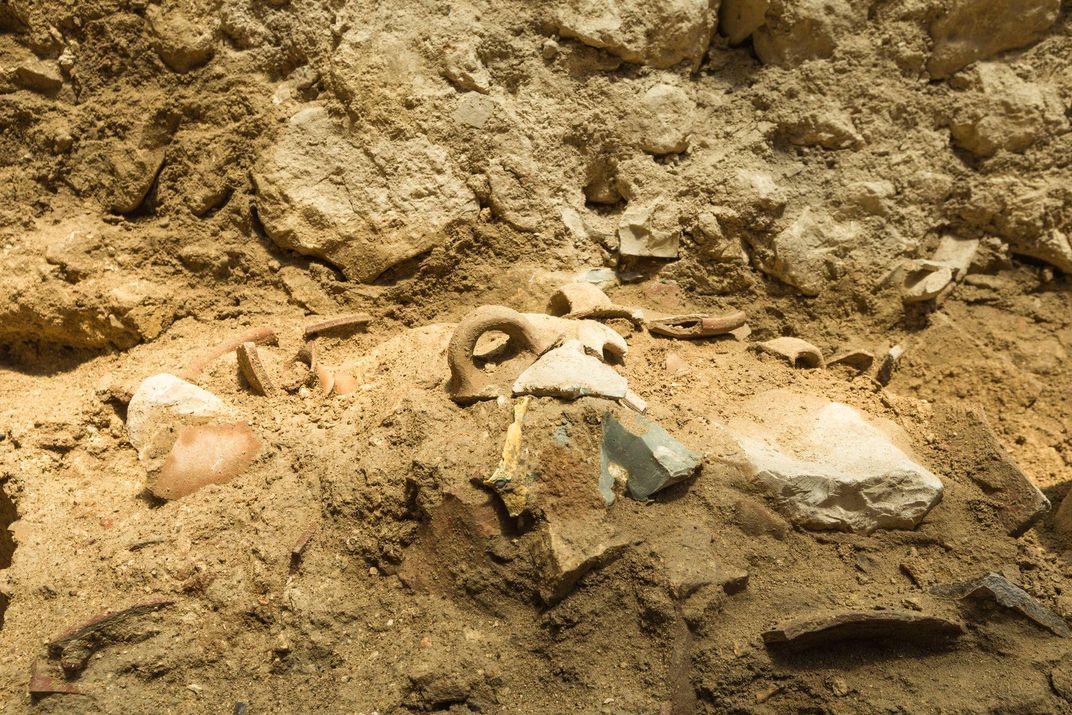Researchers Find Physical Evidence of Earthquake Described in Old Testament
Excavations in Jerusalem revealed damage dating to the eighth century B.C.E., when the natural disaster reportedly took place
:focal(1033x731:1034x732)/https://tf-cmsv2-smithsonianmag-media.s3.amazonaws.com/filer/57/0b/570bc663-28f1-4e9c-9f20-107c56553d5a/230198041_4398052420217686_2659736733922764267_n.jpeg)
Archaeologists in Jerusalem have found evidence of damage to buildings and pottery that may have been caused by a huge, eighth-century B.C.E. earthquake mentioned in the biblical books of Amos and Zechariah.
Excavations led by the Israel Antiquities Authority (IAA) and the Ir David Foundation unearthed a layer containing the ruins in the east Jerusalem neighborhood of Silwan, reports Nir Hasson for Haaretz. The findings add to evidence of the earthquake previously discovered elsewhere in Israel and in the seabed of the Dead Sea.
The researchers say they considered other possible explanations for the damage, including fire, but found no ash or other evidence suggesting the city was burned at that time. They also looked at the possibility that the destruction was isolated to one spot.
“[T]o prove that this doesn’t involve one building that sustained an isolated trauma, we compared it to other sites, both in Jerusalem and at other places where we also see this layer, so that we can make the connection and say that this isn’t an isolated event but rather something more widespread,” Joe Uziel, an archaeologist with the IAA, tells Haaretz.
As the Times of Israel’s Amanda Borschel-Dan writes, biblical accounts treat the earthquake as a benchmark event, much like people today might use the start of the Covid-19 pandemic to situate stories in time.
The first verse of the Book of Amos states that the events the narrator plans to relay took place “two years before the earthquake, when Uzziah was king of Judah.” (King Uzziah is believed to have ruled in the mid-eighth century.) Centuries later, the writer of the Book of Zechariah predicted a future earthquake with the warning “You will flee as you fled from the earthquake in the days of Uzziah king of Judah.”
“Destructive earthquakes in Jerusalem are possible, as shown by the well-recorded earthquake of 1927,” Israel Finkelstein, an archaeologist at Tel Aviv University who was not involved in the new research, tells the Times. “… The early layer of the book of Amos includes materials which relate to the eighth century and hence it is possible that a devastating earthquake left a strong impression and was recorded.”

Work conducted by Finkelstein and his colleagues at the ancient city of Megiddo, about 80 miles north of Jerusalem, found evidence of an earthquake from a similar period. As Ruth Schuster reported for Haaretz in 2019, that team described “tilted walls and pillars, bent and warped walls, fractured building stones, dipping floors, liquefied sand, mudbrick collapse and burnt remains.” Archaeologists have also recorded sites with destruction layers from the mid-eighth century at Hazor and Acre—both located north of Megiddo—and southwest of Jerusalem at Lachish.
Researchers have previously used carbon-14 dating of organic matter to find evidence of seismic activity in the Dead Sea area. Their results show that two major quakes could have occurred in the eighth century, with one taking place between 861 and 705 B.C.E and the other between 824 and 667 B.C.E.
Wolfgang Zwickel, a scholar of the Old Testament at the Johannes Gutenberg University of Mainz, told Haaretz that it’s possible the two events were collapsed into one in the historical telling, or that Amos was referring to whichever event was stronger.
Per a statement, Uziel and Ortal Kalaf, both excavation directors for the IAA, will present their full findings to the public at the City of David’s Megalim Institute on September 2.
/https://tf-cmsv2-smithsonianmag-media.s3.amazonaws.com/accounts/headshot/Livia_lg_thumbnail.png)


/https://tf-cmsv2-smithsonianmag-media.s3.amazonaws.com/accounts/headshot/Livia_lg_thumbnail.png)